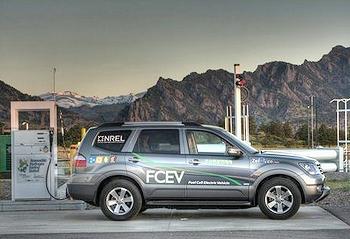 根據一項世界最大規模、為期最長的氫氣燃料電池車及加氣技術示範計畫,燃料電池車(FCEV)可能在2014到2016年間步入市場化階段。
根據一項世界最大規模、為期最長的氫氣燃料電池車及加氣技術示範計畫,燃料電池車(FCEV)可能在2014到2016年間步入市場化階段。
這項由美國能源部國家再生能源實驗室(NREL)執行的計畫,共歷時7年的實境驗證,期間動用了183輛車、行駛50萬次達360萬英里的里程,每秒傳回再生能源實驗室的資料,累積達15萬4千小時之多。
這項計畫也動用25個氫燃料站,經3.3萬次加氣,共使用了15.2萬公斤的氫氣。
因氫氣是種引爆性氣體,安全問題經過嚴密分析後,「沒有發現任何根本性的安全問題。」NREL燃料電池與氫技術專案經理Keith Wipke如此表示。
「這個計畫結果顯示,燃料電池電車進展迅速。」Wipke說明,「儘管全世界的汽車製造商和研究人員還在煩惱如何兼顧電池持久力、成本與量產能力;但應該可以樂觀的說,製造商在幾年內就可把FCEV導入市場。」
燃料電池車仰賴的是氫氣而非石油。在車上的燃料電池元件內,儲存的氫氣與空氣中的氧氣會產生電化學反應,將化學能轉為電能來供應汽車發動,且唯一的排放氣體是水氣跟熱氣。
NREL的驗證計畫從2004年展開,有四大汽車製造廠參與此計畫,包含通用汽車、戴姆勒、現代起亞(Hyundai-Kia)、福特,以及三個能源合作伙伴:殼牌、BP、雪弗龍,一齊提供數據供實驗室分析。
此項計劃的三大目的為:評估燃料電池的持續力、汽車續航力,以及計算實際氫氣製造成本,並比較與能源部所訂目標之差距。
技術分析顯示,至少其中一家車廠的汽車續航力及電池持續力超過了計劃目標。
至於降低在地氫氣生產成本的目標,Wipke解釋,這很難在示範計畫中驗證,因為目前還沒有完全依商業使用所設計、建造及使用的充電站。
儘管這個計畫還未達到能源部的氫燃料成本目標,一個獨立審查小組正在分析生產成本的問題,他們會負責至少提出一種方法,讓一般汽油加油站大小的氫燃料電池加氣站可以商業化運作。
Wipke說明,這個方法就是從天然氣中生產氫氣,有越來越多方式取得低廉的天然氣,氫氣的成本可望在未來降低。
由NREL六位科學家共同撰寫的示範計畫報告指出,「燃料電池車在最近的7年裡突飛猛進。」報告中還提到,他們「持續的進展可讓汽車製造商在2014到2016年間,投入上千部燃料電池車進入市場,這會是氫能源社群第一次的機會,來實際檢驗大眾能否接受氫能源科技。」

2011年11月,美國第一個氫燃料加油站,燃料由一氫氣工業管線直接供應。
此供氣站位於加州Torrance,是Toyota、Air Products、殼牌、南海岸空氣品質管理區及能源部的合作案,
為洛杉磯區的燃料電池車隊補充氫氣。(照片提供:美國再生能源實驗室)
The world’s largest, longest hydrogen fuel cell electric vehicle and hydrogen fueling demonstration indicates that automakers could bring FCEVs to market in the 2014-2016 timeframe.
During the seven-year real-world validation project, the U.S. Department of Energy’s National Renewable Energy Laboratory deployed 183 vehicles travelling 3.6 million miles through 500,000 trips, resulting in 154,000 hours of second-by-second data delivered to NREL.
The project also deployed 25 hydrogen fueling stations that produced or dispensed 152,000 kilograms of hydrogen through more than 33,000 fueling events.
Because hydrogen is an explosive gas, safety issues were carefully analyzed, but “no fundamental safety issues were identified,” said Keith Wipke, acting manager of NREL’s Fuel Cell and Hydrogen Technologies Program.
“The project results show that fuel cell electric vehicles have advanced rapidly,” said Wipke.
“As vehicle manufacturers and other researchers worldwide continue to focus on the remaining challenges of balancing durability, cost, and high-volume manufacturability, there is optimism that manufacturers will introduce FCEVs to the market within the next few years,” he said.
Fuel cell cars run on hydrogen gas rather than gasoline. In the car’s fuel cell stack, an electrochemical reaction occurs between hydrogen stored in a tank onboard and oxygen in the air that converts chemical energy into electrical energy to run the vehicle. The only emissions are water vapor and heat.
NREL’s Learning Demonstration project started in 2004 with four major vehicle manufacturers – General Motors, Daimler, Hyundai-Kia, and Ford – and three energy partners – Shell, BP, and Chevron – contributing data for NREL analysis.
The three primary goals of the project were to evaluate fuel cell durability, vehicle driving range, and on-site hydrogen production cost and compare to Energy Department targets.
Technical results showed that at least one of the four industry teams exceeded each of the FCEV targets for driving range and fuel cell durability.
Low on-site hydrogen production costs were difficult to demonstrate through this project because current hydrogen stations were not designed, constructed, and used as full-scale commercial stations, Wipke explained.
While this project did not achieve the Energy Department’s hydrogen cost target, an independent review panel examined the issue of hydrogen production costs and determined that the production cost target could be met for at least one pathway in commercialized hydrogen stations at sizes comparable to gasoline stations.
That pathway was hydrogen produced from natural gas. With increased availability of low-cost natural gas, hydrogen costs can be decreased even further, Wipke said.
From the project results that NREL has generated, the six-author team concludes that, “FCEVs have advanced rapidly in the last seven years.”
The authors write that they “expect continued progress to lead to several vehicle manufacturers introducing thousands of vehicles to the market in the 2014–2016 timeframe, at which time the hydrogen community will have its first true test of whether the technology will be embraced by the public.”
※ 全文及圖片詳見 ENS





